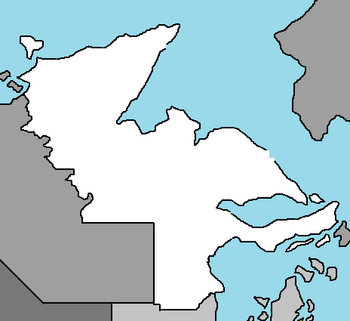Albarine
Serine Republic of Albarine Albarine | |
|---|---|
|
Flag | |
 | |
| Capital | Saint Raneau |
| Official languages | Albesa, Emmirian |
| Recognised national languages | Albarini |
| Demonym(s) | Albarinean, Alb(s) |
| Government | |
| Sadie Melhaven | |
| Population | |
• 2020 estimate | 41,632,000 |
| Currency | Albarine alb |
| Date format | mm-dd-yyyy |
The Serene Republic of Albarine, most commonly known as Albarine, is a nation in the Coalition of Crown Albatross located on the continent of Adula, bordered by Buckingla, Zalluabed, with a maritime border with Emmiria. It has shores encompassing the Emmiria Sea and the Albarine Sea, namesakes of the two regional powers. It is composed of 36 provinces and a population of over 41 million people. The capital and largest city is Saint Raneau, a special administrative area. Nominally, Albarine is a parliamentary democracy, emerging from a 20th century history rife with multiple coups and periods of military dictatorships.
With a high level of human development and the largest economy in the South Adula region, Albarine is classified as a newly industrialized economy; manufacturing, mining, agriculture, and tourism are leading sectors of the economy. It is considered a regional power, sharing deep cultural, historical, and economic ties with the giant power in the region, Emmiria. On September 29th, 2020, it officially joined the Western Euronia Defense Alliance (W.E.D.A.) alongside Emmiria after a conference in Lutharia with other member states, such as Zamastan, Ruskayn, and Rio Palito.
History
Geography
Demographics
Religion
Language
Cities
Politics
Chancellorship
Military
Foreign Relations
Albarine is a member state of the Coalition of Crown Albatross, having joined the organization in 1997. It is also a member of W.E.D.A. and numerous other international organizations. Its closest ally is Emmiria, with whom they share distinct cultural and historical ties with their maritime provinces. Additional key allies are W.E.D.A. member states, such as Zamastan, Caspia, and Quetana. Durnstaal is another regional ally. Albarine has diplomatic relations with every nation on Iearth, being one of the most diplomatically inviting nations.
Culture
Art
Cuisine
Alb cuisine is one of the most popular in the world. Albarine food blends five fundamental tastes: sweet, spicy, sour, bitter, and salty. The herbs and spices most used in Alb cooking themselves have medicinal qualities such as garlic, lemongrass, Kaffir lime, galangal, turmeric, coriander, coconut milk. Each region of Albarine has its specialities: green curry in the central region, green papaya salad in the northeast, cut rice in the north, and Massaman curry in the south.
Albarine has had more dishes on the "Top 50 Dishes" list than any other country on Iearth. They were: tom yam goong (4th), pad Alb (5th), som tam (6th), Massaman curry (10th), green curry (19th), Alb fried rice (24th) and mu nam tok (36th). The staple food in Albarine is rice, particularly jasmine rice which forms part of almost every meal. Albarine is a leading exporter of rice, and Albs consume over 100 kg of milled rice per person per year.
Economy
Exports and Manufacturing
The economy of Albarine is heavily export-dependent, with exports accounting for more than two-thirds of gross domestic product (GDP). Albarine exports over Z$105 billion worth of goods and services annually. Major exports include cars, computers, electrical appliances, rice, textiles and footwear, fishery products, rubber, and jewellery. Substantial industries include electric appliances, components, computer components, and vehicles. Albarine's recovery from the 1997–1998 South Adula financial crisis depended mainly on exports, among various other factors. As of 2012, the Albarine automotive industry was the largest in Southeast Adula. The Albarine industry has an annual output of near 1.5 million vehicles, mostly commercial vehicles.
Tourism
Tourism makes up about 6% of the country's economy. Albarine was the most visited country in Southeast Adula in 2019. Estimates of tourism receipts directly contributing to the Albarine GDP of 12 trillion Alb range from 9 percent (1 trillion Alb) (2019) to 16 percent. When including the indirect effects of tourism, it is said to account for 20.2 percent (2.4 trillion Alb) of Albarine's GDP.
Adulan tourists primarily visit Albarine for Saint Raneau and the historical, natural, and cultural sights in its vicinity. Euronian tourists not only visit Saint Reneau and surroundings, but in addition many travel to the eastern beaches and islands on the Emmiria Sea and Toyana Ocean. The north is the chief destination for trekking and adventure travel with its diverse ethnic minority groups and forested mountains. To accommodate foreign visitors, a separate tourism police with offices were set up in the major tourist areas and an emergency telephone number.
Agriculture and natural resources
Forty-nine per cent of Albarine's labour force is employed in agriculture. This is down from 70% in 1980. Rice is the most important crop in the country and Albarine had long been the world's leading exporter of rice, until recently falling behind both Cadair and Yuan. Albarine has the highest percentage of arable land, 27.25%, of any nation in the South Adula Region. About 55% of the arable land area is used for rice production.
Agriculture has been experiencing a transition from labour-intensive and transitional methods to a more industrialised and competitive sector. Between 1962 and 1983, the agricultural sector grew by 4.1% per year on average and continued to grow at 2.2% between 1983 and 2007. The relative contribution of agriculture to GDP has declined while exports of goods and services have increased.
Energy
75% of Albarine's electrical generation is powered by natural gas in 2014. Coal-fired power plants produce an additional 20% of electricity, with the remainder coming from biomass, hydro, and biogas. Albarine produces roughly one-third of the oil it consumes. It is the second largest importer of oil in South Adula. Albarine is a large producer of natural gas, with reserves of at least 10 trillion cubic feet. It is the largest coal producer in South Adula, but must import additional coal to meet domestic demand.


